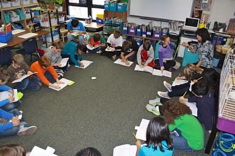As the end of the year approaches, we all receive that dreaded email. The one that reads something like this:
Dear Friend,
It’s hard to believe it is already May 1. We need your library books returned by May 15 so we can complete our inventory.
Thank you,
Your Media Team
A few days later this one pops up:
Happy Friday,
Whew! What a week! I know you are all busy completing end-of-year assessments and winding down your year. By the end of next week, we need your books for small-group reading instruction returned to the bookroom. Please make sure all sets are complete upon return. We need to complete our inventory before leaving for the summer.
Much appreciated!
Your Bookroom Team
Followed by the one that says:
Happy Monday,
OH MY GOODNESS! The days are flying by. We need all of your classroom devices, with their contents removed and set back to factory settings, yesterday.
You rock!
Your Technology Team
Pardon my drama. It isn’t exactly like that. However, the end of the year does bring those weeks where our materials have to be returned for inventory and yet our students are still coming into the room to learn each day. The school library needs our books back, the building bookroom needs our collections used for small-group instruction, and technology needs our classroom devices. If you’re lucky, this may be for only a week of your instruction, but often that is not the case.
I get it. We all get it. There’s a lot to do to make sure materials are back before the end of the year. However, I’ve always been someone who prefers to teach until the end of the year. If I wake up at 3:00 in the morning, you can bet I’m going back to sleep. Every hour of sleep makes a difference, and so does every day of learning. Without these books and materials that we’ve become accustomed to all year, the teaching and learning is certainly a little tricky. If we aren’t careful, the last few weeks can feel more like a lesson in crowd control. Experience has taught me that the more I stay focused on the learning, the better our end of year. Over the years, I’ve developed a few ways to keep the learning going when all of the materials are required to be returned.
Thank You, Public Library: My first move is to pull out my public library card—okay, maybe both of them—and max out the number of checkouts I’m allotted. Checking out a big batch of new books always reenergizes our literacy workshops. Using these books as read-alouds can give our lessons a boost and lift the learning in our community. My students have grown as learners since the fall and are ready for new challenges and possibilities. Adding these books to our classroom library really sparks independent reading during our workshop.
Poetry, Please! Poetry has many places in our learning across the year, but I really love it at the end of the year. Poetry always sparks a little joy. It allows us to dig a bit more into the sounds of language and the power of words. Since April is National Poetry Month—and I’m a bit of a poetry nerd—we have often just been celebrating all things poetry. Poetry anthologies added to our classroom library can provide new possibilities for readers and writers.
Taking advantage of all we have learned, this is the perfect time to create our own classroom anthologies. In these days without materials, young poets can enjoy filling the school with poetry. What’s better than poetry spilling into the hallways, by the water fountain, or along the walls of the cafeteria? Of course, the end of the year is a good time to play Poetry Tag in the classroom, across the building, or around the world. Don’t forget your copy of PoetryTagTime: 30 Poems by 30 Poets compiled by Sylvia Vardell and Janet Wong to kick things off.
Let’s Reflect: I’m always a bit sorrowful at the end of the year, knowing our community is in its last days. Though these students will move through school together, it will never be exactly like this. To make myself feel better, I work to find time to celebrate how much they have learned and grown. I used to do this in quiet afternoons after students had gone home for the day, but I eventually realized that it was even better to have students do this reflection and celebrate alongside them. During this time, we pull out the lists of books we have read (sometimes these are on paper, sometimes Padlet, sometimes Flipgrid, etc.) to look at how we have grown as readers. What were our favorite authors, topics, or series? Do we prefer particular genres? How has the complexity of our reading changed? Then we pull out our writing. This is always entertaining as writers marvel over the growth they can so readily see in their writing.
More Community Reading and Writing: The last month of school is the perfect month to remember the power of read-aloud, shared reading, shared writing, and interactive writing. Across the year, student stamina for reading, writing, and long conversations has grown. This makes this the perfect time to choose read-alouds that ask the community to dig a little deeper in their thinking and understanding. This time of year, I always find our learning community can have fascinating conversations about the bigger ideas and themes of books. Additionally, shared reading can provide opportunities during this time.
Poetry, mentioned above, can easily be used for shared reading. Poems read together can be copied and available for students during independent reading. Shared and interactive writing opportunities can allow the learning community to revisit some of the themes from their writing, play with new craft moves, and create texts to read again and again.
Getting Reading for Summer: During this time of year our community transitions from reflections of our year toward summer planning for our reading and writing. We are deliberate about making plans for reading over break. With all of those new books from the library, this is a great time to make reading plans for the summer. If I am able to check out a device or two, or have been lucky enough to keep a few in our classroom, I find that students like to visit the websites of favorite authors to learn about other books they have written.
In addition to building our reading plans, we spend time dreaming about the writing we might do. What better way to kick of writing plans than with a new writer’s notebook? During this time of year, I like to purchase composition notebooks, have students bring in stickers or pictures to decorate the front, and design a writing notebook for the summer. Once we have the notebook designed, writers can begin collecting ideas for summer writing. Students can brainstorm a list or draw pictures of possibility. Having students share their ideas with one another amplifies the possibilities for summer writing.
Welcome a New Community: As we get close to the end of the year and our schedule becomes almost impossible to maintain, I ask the community to brainstorm ways to welcome next year’s class into the room. Across years, groups have decided to make posters of favorite books or authors they read during the year, create lists of book collections I should surely have ready for the new students, and write about favorite parts of their learning. All of this work can then be hung during open house the following year to welcome students into the classroom and give parents a snippet of what is to come. Additionally, I have found that my new students love seeing the work of siblings and neighbors on display—and that I’m always comforted by the snapshots as I miss one community but open my heart to a new one.
The end of the year brings countless to-do lists. As teachers, we understand the work our media specialists, bookroom teams, and technology teachers do—and the challenge of getting materials collected, checked in, and put away before the end of the year. Being ready for the change in the availability of instructional materials can help us change those last days from days of survival to days of revival. Some intentional planning can help learning continue in those final days, build bridges to summer possibilities, and bring closure to our communities. In September we help learners step from home into our classrooms, and the final days allow the opportunity to slowly help them take all they’ve learned back home again.






